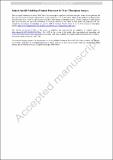Subject-Specific Modeling of Implant Placement for Type I Thyroplasty Surgery
Author(s)
Li, Zheng; Wilson, Azure; Sayce, Lea; Ding, Alice; Rousseau, Bernard; Luo, Haoxiang; ... Show more Show less
Download10439_2023_3250_ReferencePDF.pdf (853.3Kb)
Publisher Policy
Publisher Policy
Article is made available in accordance with the publisher's policy and may be subject to US copyright law. Please refer to the publisher's site for terms of use.
Terms of use
Metadata
Show full item recordAbstract
Abstract
Type I thyroplasty is widely used to improve voice production in patients affected by unilateral vocal fold paralysis. Almost two-thirds of laryngologists report using Silastic® implants to medialize the vocal fold, with implant size, shape, and location determined experientially. However, post-surgical complications arising from this procedure (extrusion, migration, resizing) necessitate revision in 4.5–16% of patients. To improve initial surgical outcomes, we have developed a subject-specific modeling tool, PhonoSim, which uses model reconstruction from MRI scans to predict the optimal implantation location. Eleven vocal fold sample sides from eight larynges of New Zealand white rabbits were randomized to two groups: PhonoSim informed (n = 6), and control (no model guidance, n = 5). Larynges were scanned ex vivo in the abducted configuration using a vertical-bore 11.7 T microimaging system, and images were used for subject-specific modeling. The PhonoSim tool simulated vocal fold adduction for multiple implant location placements to evaluate vocal fold adduction at the medial surface. The best implant placement coordinates were output for the 6 samples in the PhonoSim group. Control placements were determined by the same surgeon based on anatomical landmarks. Post-surgical MRI scans were performed for all samples to evaluate medialization in implanted vocal folds. Results show that PhonoSim-guided implantation achieved higher vocal fold medialization relative to controls (28 to 55% vs. − 29 to 39% respectively, in the glottal area reduction), suggesting that this tool has the potential to improve outcomes and revision rates for type I thyroplasty.
Date issued
2023-06-01Department
Massachusetts Institute of Technology. Department of Nuclear Science and EngineeringPublisher
Springer International Publishing
Citation
Li, Zheng, Wilson, Azure, Sayce, Lea, Ding, Alice, Rousseau, Bernard et al. 2023. "Subject-Specific Modeling of Implant Placement for Type I Thyroplasty Surgery."
Version: Author's final manuscript